As a writer, what city could be more inspiring and intimidating to live in than New York? Googling "
famous New York City writers," my intimidation takes on a face, or many faces, as I read through even a partial list. . .
Noel Coward
Eugene O'Neill
Jack Kerouac
E. B. White
Willa Cather
E E Cummings
Allen Ginsburg
Arther Miller
Edna St. Vincent Millay
Edgar Allen Poe (who knew??)
Some of them came and went, some came and stayed, but each shared a unique connection to this city.
Barely surviving in cold water flats with square footage so minuscule it could scarcely be measured, hands freezing in threadbare gloves, shoulders hunched over a borrowed typewriter or pencil and legal pad, these writers sacrificed all for their craft. Their lines of genius, just waiting to be discovered!
Highly romanticized, melodramatic and stereotypical, I grant you, but with enough grains of truth to inspire
this writer, and thousands of others, to open their laptops or sharpen their pencils each day.
Yet, what is it about this city that fuels my
own passion to write, encourages me to take risks, grow, learn, to become a better writer? Having lived here only 2 months, I'm still early in the discovery process, but two critical areas have already surfaced.
Other writers. . .
Stepping yards beyond my writing comfort zone, I began a 4-week Poetry Workshop last week through
The Sackett Street Writers in Brooklyn.
 |
| Sackett Street where the writing group began in 2002 |
My first writing group! Five writers gather around a table sharing our work. I hear comments from others which I've expressed many times myself, always in isolation.
"This is hard!"
"I've revised this so many times, I've lost the feeling I started out with."
"Yes! finally after 3 hours, I found the exact word that works in this line." (Only other writers can get excited about such things.)
I feel a huge sense of relief to be among fellow writers, knowing that for two hours on Monday evenings, I can open the door of my solitary writing room and mingle with people who speak the same language. It's like being invited to a party.
We read poetry by writers I've heard of, like
Mary Oliver, and others I haven't like,
William Heyen.
We're encouraged to write styles of poetry we've never tried.
We learn how to "read with a writer's perspective."
We grow.
New sights. . .
Obvious, yes, but beyond the obvious.
A single tree on a gently sloping hill in Central Park caught my attention last week as I wandered, without direction or intention. I sat under its yellowing leaves, ate my peanut butter and jelly sandwich and wrote a poem.
Opportunities for writing in New York City proclaim themselves as loudly as the Empire State Building and as shyly as the tree. The exhilaration comes in never knowing what will speak to my soul, challenge me to put what I see and feel into words. The next sight might be a homeless man asleep by the entrance to Dunkin' Doughnuts,
Van Gogh's "Irises" on the wall of the Metropolitan Museum of Art, a
freak October snowstorm, or. . . .
The city will provide what I need. My job is to make the connections,
in the rich tradition of countless writers before me,
and keep sharpening those pencils.






















































